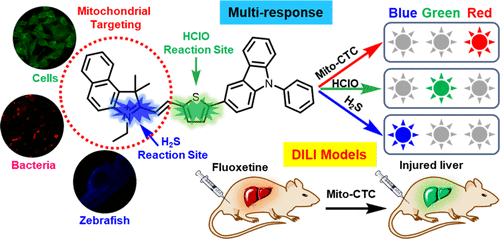当前位置:
X-MOL 学术
›
ACS Appl. Bio Mater.
›
论文详情
Our official English website, www.x-mol.net, welcomes your feedback! (Note: you will need to create a separate account there.)
Mitochondria-Targeted Chemosensor to Discriminately and Continuously Visualize HClO and H2S with Multiresponse Fluorescence Signals for In Vitro and In Vivo Bioimaging
ACS Applied Bio Materials ( IF 4.7 ) Pub Date : 2020-09-08 , DOI: 10.1021/acsabm.0c01029 Xiaojun He 1 , Ziman Zheng 2 , Feifan Zhang 2 , Chuchu Xu 1 , Wei Xu 1 , Lisong Ye 1 , Xiaoshuai Sun 1 , Zhan Zhou 2 , Jianliang Shen 1, 3
ACS Applied Bio Materials ( IF 4.7 ) Pub Date : 2020-09-08 , DOI: 10.1021/acsabm.0c01029 Xiaojun He 1 , Ziman Zheng 2 , Feifan Zhang 2 , Chuchu Xu 1 , Wei Xu 1 , Lisong Ye 1 , Xiaoshuai Sun 1 , Zhan Zhou 2 , Jianliang Shen 1, 3
Affiliation

|
Bioactive molecules play a vital role in the process of regulating the redox balance in the intracellular environment, especially in maintaining the function of organelles. To explore the association and function of bioactive molecules in organelles, it is essential to develop a chemosensor tool that uses multiresponse fluorescence signals to distinguish between and track two related bioactive molecules in organelles. However, the development of sensors with multiresponse functions is still a challenging task. Herein, we present a unique and practical single chemosensor (Mito-CTC) that can monitor HClO (as an oxidative substance) and H2S (as a reductive substance) in mitochondria (organelle targeting) with multiresponse fluorescence signals. The response of the sensor to HClO and H2S changes from red to green and blue channel emission simultaneously, respectively, thereby providing a specific signal response to reductive/oxidative substances in the mitochondria. Using a single chemosensor, we have realized multichannel bioimaging of the exogenous and endogenous HClO and H2S in cellular mitochondria. Additionally, the excellent properties of the sensor Mito-CTC can be used to reveal the relationship between HClO and H2S in mitochondria. Meanwhile, Mito-CTC has been endowed with the ability to image in bacteria and zebrafish attributed to the good permeability and low cytotoxicity. Expectantly, drug-induced liver injury (DILI) caused by fluoxetine (an antidepressant drug) and the degree of drug-induced toxicity to the liver were evaluated using Mito-CTC through discriminating and imaging HClO, indicating that Mito-CTC has the potential function of evaluating the toxicity of the drug to the liver.
中文翻译:

线粒体靶向化学传感器可通过多响应荧光信号区分和连续可视化 HClO 和 H2S,用于体外和体内生物成像
生物活性分子在调节细胞内环境中的氧化还原平衡的过程中起着至关重要的作用,尤其是在维持细胞器的功能方面。为了探索细胞器中生物活性分子的关联和功能,必须开发一种化学传感器工具,该工具使用多响应荧光信号来区分和跟踪细胞器中的两种相关生物活性分子。然而,具有多响应功能的传感器的开发仍然是一项具有挑战性的任务。在此,我们提出了一种独特而实用的单一化学传感器 ( Mito-CTC ),它可以通过多响应荧光信号监测线粒体(细胞器靶向)中的 HClO(作为一种氧化物质)和 H 2 S(作为一种还原物质)。传感器对 HClO 和 H 的响应2 S 分别从红色通道发射变为绿色通道发射和蓝色通道发射,从而为线粒体中的还原/氧化物质提供特定的信号响应。使用单个化学传感器,我们实现了细胞线粒体中外源性和内源性 HClO 和 H 2 S 的多通道生物成像。此外,传感器Mito-CTC的优异特性可用于揭示线粒体中HClO 和 H 2 S 之间的关系。同时,Mito-CTC由于良好的渗透性和低细胞毒性,已被赋予在细菌和斑马鱼中成像的能力。Mito-CTC通过对HClO的判别和成像,对氟西汀(一种抗抑郁药)引起的药物性肝损伤(DILI)和药物对肝脏的毒性程度进行了评估,表明Mito-CTC具有潜在的功能。评估药物对肝脏的毒性。
更新日期:2020-11-16
中文翻译:

线粒体靶向化学传感器可通过多响应荧光信号区分和连续可视化 HClO 和 H2S,用于体外和体内生物成像
生物活性分子在调节细胞内环境中的氧化还原平衡的过程中起着至关重要的作用,尤其是在维持细胞器的功能方面。为了探索细胞器中生物活性分子的关联和功能,必须开发一种化学传感器工具,该工具使用多响应荧光信号来区分和跟踪细胞器中的两种相关生物活性分子。然而,具有多响应功能的传感器的开发仍然是一项具有挑战性的任务。在此,我们提出了一种独特而实用的单一化学传感器 ( Mito-CTC ),它可以通过多响应荧光信号监测线粒体(细胞器靶向)中的 HClO(作为一种氧化物质)和 H 2 S(作为一种还原物质)。传感器对 HClO 和 H 的响应2 S 分别从红色通道发射变为绿色通道发射和蓝色通道发射,从而为线粒体中的还原/氧化物质提供特定的信号响应。使用单个化学传感器,我们实现了细胞线粒体中外源性和内源性 HClO 和 H 2 S 的多通道生物成像。此外,传感器Mito-CTC的优异特性可用于揭示线粒体中HClO 和 H 2 S 之间的关系。同时,Mito-CTC由于良好的渗透性和低细胞毒性,已被赋予在细菌和斑马鱼中成像的能力。Mito-CTC通过对HClO的判别和成像,对氟西汀(一种抗抑郁药)引起的药物性肝损伤(DILI)和药物对肝脏的毒性程度进行了评估,表明Mito-CTC具有潜在的功能。评估药物对肝脏的毒性。


























 京公网安备 11010802027423号
京公网安备 11010802027423号